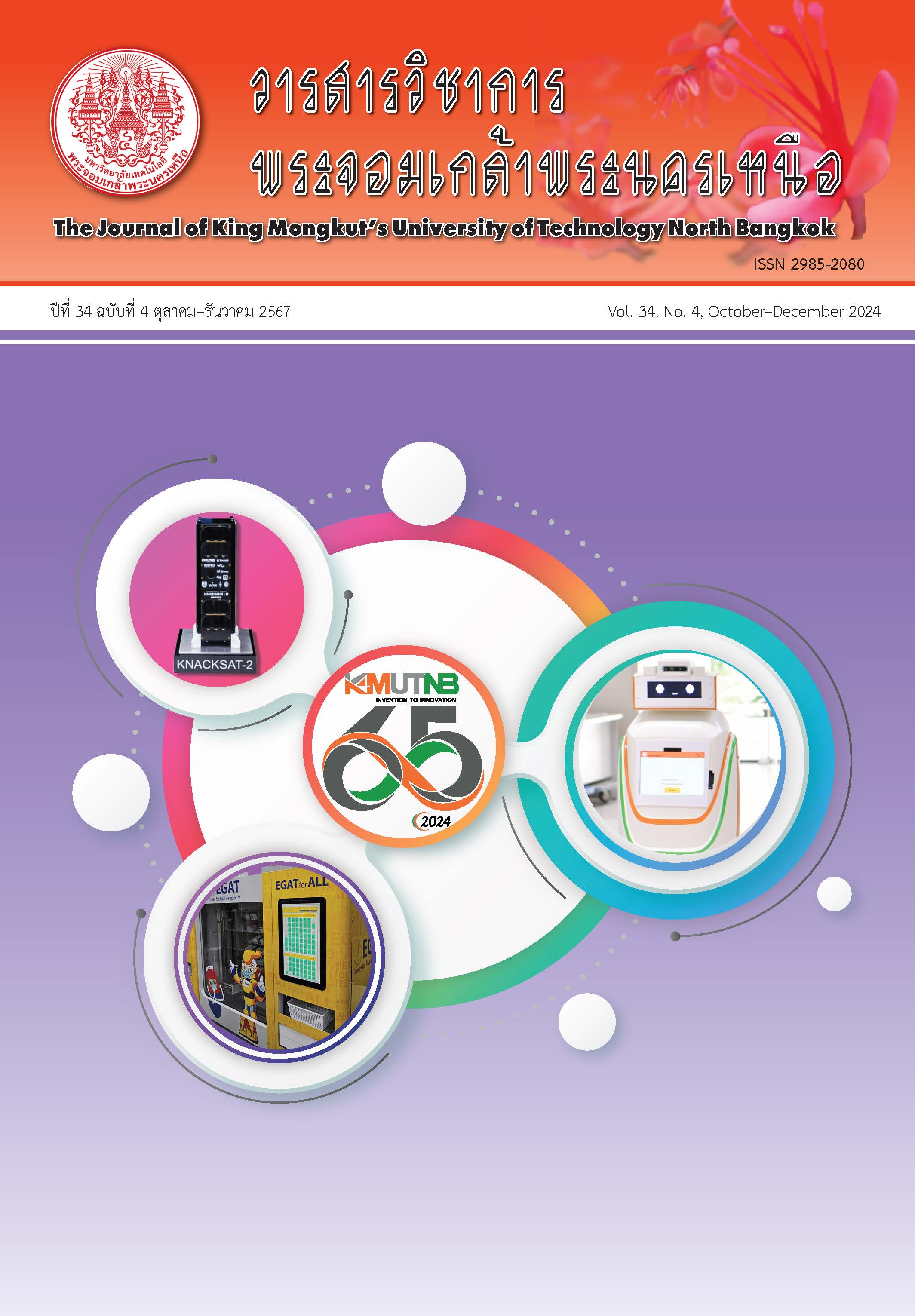Preparation and Properties of Pineapple Leaf Fiber Based Thermoplastic Modified Starch Composite
Main Article Content
Abstract
The purpose of this research was to study the preparation and properties of Pineapple Leaf Fiber (PALF) based Thermoplastic Modified Starch (TPMS) composites with pineapple leaf fiber content at 0, 2, 4, 6, and 8 phr respectively by using an internal mixer. The test specimens were prepared by compression molding machine. Mechanical properties, Melt Flow Index (MFI) and morphological properties of thermoplastic modified starch combined with pineapple leaf fiber content were studied. The results showed that tensile strength and young’s modulus increased with an increasing of PALF content. However, elongation at break (%) and impact strength decreased with an increasing of PALF content. The Melt Flow Index showed that non-reinforced TPMS had a higher MFI than the thermoplastic modified starch composites. Moreover, the MFI of thermoplastic modified starch composites decreased with the increasing PALF content. The morphology of thermoplastic modified starch composites as captured by Scanning Electron Microscopy (SEM) illustrated that PALF had a good adhesion with thermoplastic modified starch. Therefore, the results showed tensile strength and young’s modulus increased.
Article Details

This work is licensed under a Creative Commons Attribution-NonCommercial-NoDerivatives 4.0 International License.
The articles published are the opinion of the author only. The author is responsible for any legal consequences. That may arise from that article.
References
A. K. Mohanty, M. Misra, and L. T. Drzal, “Sustainable bio-composites from renewable resources: opportunities and challenges in the green materials world,” Journal of Polymers and the Environment, vol 10, no. 1, pp. 19–26, 2002.
A. Wattanakornsiri, K. Pachana, S. Kaewpirom, M. Traina, and C. Migliaresi, “Preparation and properties of green composites based on tapioca starch and differently recycled paper cellulose fibers,” Journal of Polymers and the Environment, vol. 20, no. 3, pp. 801–809, 2012.
S. Kaewpirom, and C. Worrarat, “Preparation and properties of pineapple leaf fiber reinforced poly (lactic acid) green composites,” Fibers and Polymers, vol. 15, no. 7, pp. 1469–1477, 2014.
M. Akrami, I. Ghasemi, H. Azizi, M. Karrabi, and M. Seyedabadi, “A new approach in compatibilization of the poly (lactic acid)/ thermoplastic starch (PLA/TPS) blends,” Carbohydrate Polymers, vol. 144, pp. 254–262, 2016.
V. P. Cyras, L. B. Manfredi, M. T. Ton-That, and A. Vázquez, “Physical and mechanical properties of thermoplastic starch/montmorillonite nanocomposite film,” Carbohydrate Polymers, vol. 73, no. 1, pp. 55–63, 2008.
S. Wangtueai, T. Chaiyaso, P. Rachtanapun, P. Jantrawut, W. Ruksiriwanich, P. Seesuriyachan, and K. Jantanasakulwong, “Thermoplastic cassava starch blend with polyethylenegrafted- maleic anhydride and gelatin coreshell structure compatibilizer,” International Journal of Biological Macromolecules, vol. 197, pp. 49–54, 2022.
R. Yoksan, A. Boontanimitr, N. Klompong, and T. Phothongsurakun, “Poly (lactic acid)/ thermoplastic cassava starch blends filled with duckweed biomass,” International Journal of Biological Macromolecules, vol. 203, pp. 369–378, 2022.
C. Ge, B. Lansing, and C. L. Lewis, “Thermoplastic starch and poly (vinyl alcohol) blends centered barrier film for food packaging applications,” Food Packaging and Shelf Life, vol. 27, pp. 100610, 2021.
K. M. Dang, R. Yoksan, E. Pollet, and L. Avérous, “Morphology and properties of thermoplastic starch blended with biodegradable polyester and filled with halloysite nanoclay,” Carbohydrate Polymers, vol. 242, pp. 116392, 2020.
P. Jariyasakoolroj, R. Supthanyakul, A. Laobuthee, A. Lertworasirikul, R. Yoksan, S. Phongtamrug, and S. Chirachanchai, “Structure and properties of in situ reactive blend of polylactide and thermoplastic starch,” International Journal of Biological Macromolecules, vol 182, pp. 1238–1247, 2021.
X. Zhao, X. Wang, L. Zeng, Q. Huang, J. Zhang, X. Wen, S. Xiong, T. Yin, and B. Zhang, “Effects of oil-modified crosslinked/acetylated starches on silver carp surimi gel: Texture properties, water mobility, microstructure, and related mechanisms,” Food Research International, vol. 158, pp. 111521, 2022.
J. Zanela, A. P. Bilck, M. O. Reis, M. V. E. Grossmann, and F. Yamashita, “Modified starches on the properties of extruded biodegradable materials of starch and polyvinyl alcohol,” Journal of Polymers and the Environment, vol. 28, no. 12, pp. 3211–3220, 2020.
P. Wongphan, T. Panrong, and N. Harnkarnsujarit, “Effect of different modified starches on physical, morphological, thermomechanical, barrier and biodegradation properties of cassava starch and polybutylene adipate terephthalate blend film,” Food Packaging and Shelf Life, vol. 32, pp. 100844, 2022.
M. L. Rinawa, P. Chauhan, A. K. Sharma, H. K. Singh, and M. S. Karuna, “Water absorption studies of pineapple leaf fiber/nano rice husk powder reinforced epoxy matrix hybrid composites,” in Materials Today: Proceedings, 2022, pp. 1498–1502.
S. S. Kumar, R. Muthalagu, and C. N. Chakravarthy, “Effects of fiber loading on mechanical characterization of pineapple leaf and sisal fibers reinforced polyester composites for various applications,” Materials Today: Proceedings, 2021, pp. 546–553.
S. S. Todkar, and S. A. Patil, “Review on mechanical properties evaluation of pineapple leaf fibre (PALF) reinforced polymer composites,” Composites Part B: Engineering, vol. 174, pp. 106927, 2019.
C. S. Raina, S. Singh, A. S. Bawa, and D. C. Saxena, “Some characteristics of acetylated, crosslinked and dual modified Indian rice starches,” European Food Research and Technology, vol. 223, no. 4, pp. 561–570, 2006.
R. Promjariyakoon, and S. Kongiang, “Effect of compatibilizer on the mechanical and cure properties of Pineapple Leaf Fiber (PALF) reinforced Natural Rubber (NR) composites,” The Journal of KMUTNB, vol. 30, no. 4, pp. 612–619, 2020 (in Thai).
J. P. López, P. Mutjé, A. J. F. D. Carvalho, A. A. D. S. Curvelo, and J. Gironès, “Newspaper fiberreinforced thermoplastic starch biocomposites obtained by melt processing: Evaluation of the mechanical, thermal and water sorption properties,” Industrial Crops and Products, vol. 44, pp. 300–305, 2013.
A. J. F. De Carvaho, A. A. S. Curvelo, and J. A. M. Agnelli, “Wood pulp reinforced thermoplastic starch composites,” International Journal of Polymeric Materials, vol. 51, no. 7, pp. 647–660, 2002.
W. N. Ota, S. C. Amico, and K. G. Satyanarayana, “Studies on the combined effect of injection temperature and fiber content on the properties of polypropylene-glass fiber composites,” Composites Science and Technology, vol. 65, no. 6, pp. 873–881, 2005.

